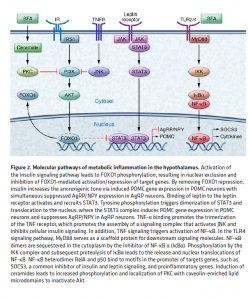
It’s finally November, nearly Thanksgiving, time for stuffing, turkey, and other delicious, unhealthy foods. Then after it all, we can pack it up and break out the Christmas decorations.
One of the most famous Christmas stories is Charles Dickens’ A Christmas Carol. Every year thousands of community theaters do a production of the play and people watch one of the countless movie adaptations. At this point, most people are familiar with the famous line the Ebenezer Scrooge says when two men come asking for donations to the poor “Let them die and decrease the surplus population.” Throughout the story, Scrooge learns the error of his ways and in classic Dickens fashion comes to understand that people are in poverty not because of personal choices, but rather because of issues beyond their control.
The same is the case for obesity. Recent discoveries indicate that this issue may not be as simple as choosing to eat healthier. Obesity, and related metabolic disorders, are really the work of complex mechanisms within the brain.
The Science
The hypothalamus is a tiny region in the brain that performs a variety of functions, including controlling hunger and metabolism. Within the hypothalamus are two kinds of neurons: POMC and AgRP neurons. Under normal conditions, the POMC neurons are activated, releasing alpha MSH from the downstream MC4R neurons. This stops us from eating so that we can have a good balance between energy expenditure and food intake.
However, in cases of insulin and/or leptin resistance the AgRP neurons are never inhibited and the POMC neurons are not activated. The signal to stop eating is never sent.
How Insulin Works
Insulin normally binds to a special kind of receptor called the RTK receptor. These receptors then autophosphorylate and dimerize (come together). This process activates IRS ½ which can then activate p85 and PI3K. PI3K can then make PIP2 which can be made into PIP3. Increased concentration of PIP3 attracts a few other important proteins to the region, mainly PDK1 and AKT. PDKI1inhibits AKT, which then inhibits AS160. It is this inhibition that allows the transporter of glucose (Glut4) to enter the membrane and draw glucose from the bloodstream.
What Goes Wrong
A high fat diet has been shown to trigger the inflammatory response. This inflammation is less of the rash and cut kind. Instead it puts the brain in a state of chronic stress that impairs cognition and only exacerbates the problem of overeating.
The Toll-like receptor 4 (TLR4) is activated by saturated fatty acids. This receptor is then able to activate MyD88 and eventually IKK beta. IKK beta is then able to remove I kapa beta from DNA and activate the transcription factor NF kapa B. This transcription factor helps transcribe genes associated with inflammatory cytokines, small proteins that are able to inhibit insulin signaling in the neuron.
TNF alpha is another inflammation pathway. This pathway activates the JNK protein which is then able to block the IRS signaling cascade by inhibiting PI3K. Insulin does not have desired effect and the signal to stop eating is not sent.
Other Mechanisms
Below is a schematic from Hypothalamic Inflammation in Obesity that summarizes the effects of overeating. In addition to the pathways described above, a high fat diet changes what neurons are made and how much energy is spent. Too many fatty acids leads to not enough energy spent, forcing the body to take in more food. This leads to and is exacerbated by insulin and leptin resistance.
[1] Hypothalamic Inflammation in obesity and metabolic disease Alexander Jais and Jens C. Buning
What does this all mean?
Obesity is a complex problem with various neural mechanisms. Each of these pathways serves to worsen the problem of overeating. Based on the science, overeating is a very hard cycle to breakout of. It is not simply the result of personal choices, but rather the brain slowly destroying itself.
If this is true, then we must make like Ebenezer Scrooge does at the end of A Christmas Carol and recognize that this situation is much more than simple personal choices. It is something bigger than ourselves.
This research is still fairly new and there is still a lot to be learned. But, this research could give hope to some people. A pharmaceutical could be developed that acts on these mechanisms, making overeating an easier cycle to escape. However, this can only be done if we come to accept that both the gravity and hope of the situation.
